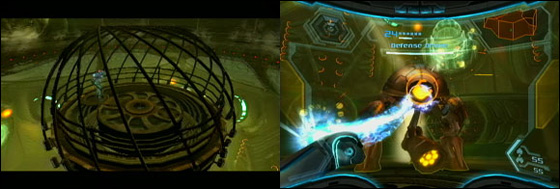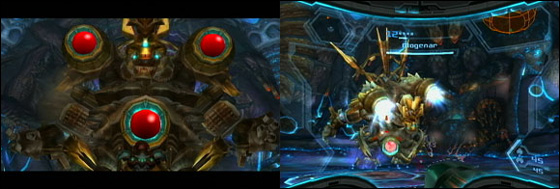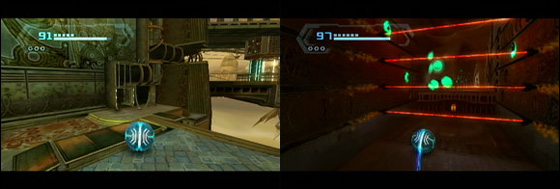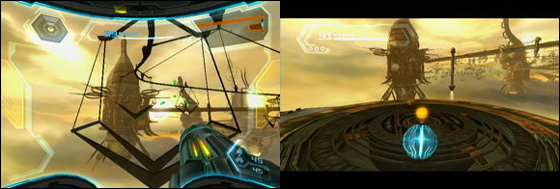Rethinking The Feature (An Alt. Model for Conventional Games Coverage)
October 10th, 2009

Ignore the important-sounding title, this is purely self-indulgence.
As you may have noticed from my recent coverage of Prince of Persia, Halo and Metroid Prime 3, I like to approach a single game from multiple contexts. The ability for a publication to frame a single game in different perspectives in different articles is tremendous. Collectively, such articles paint a richer picture of the play experience of the chosen video game, bolstering the amount of non-traditional writing about the product. It’s my kinda editorial, but unfortunately it’s the type of writing which is left for gutter writers like myself, so let’s theorize an example of an ideal break from writing conventions – cos I’m self-serving and all.
Just recently Batman: Arkham Asylum was released. This was a highly anticipated game and was also linked to a comic book licence. Let’s explore the sorts of content one could write about this game.
Pre-release
The History Behind the Canceled Dark Knight game
-Pandemic Studios were originally developing a game based on the Dark Knight licence, would be nice to see an investigative follow-up
History on Batman Games
–1UP ran a feature which fits this bill
Review Diary
-a blogging diary of the game, similar to my recent Metroid Prime 3 articles
Post Release
Authenticity to the Comics
-the lore is an integral part of AA experience, would be interesting hearing a critique from an enthusiast’s perspective
Comparison to Live-action Batman
-probably a much easier, but equally as interesting piece
Analysis of the Depiction of Inmates
-something along the lines of this
Considerations for Design Analysis
-use of fixed and in-game narrative
-melding of gameplay styles
-reference list to borrowed material (Splinter Cell, Metal Gear, Metroid Prime, Bioshock)
DLC Reviews
-reviews of the additional content
Maybe 10 articles can be ripped from this template. This includes both pre and post release material which could predominately span the month surrounding the release, with the detailed analysis extending to maybe 2 months after release. Alternatively, a second opinion piece could be submitted 6 months later.
This model of alternative games coverage breaks away from the rigid news, reviews, previews structure whilst still delivering the same message, just in a more sophisticated form. Wrap this up with developer interviews, video coverage and news tidbits and you’ve got a pretty dandy package. Now if only people would take these ideas on.
Next: Back to Metroid Prime 3
Metroid Prime 3: Quarterly Diaries #5
October 8th, 2009

Areas Covered: Elysia (Main Docking Bay)
Discussion Points: Hyper ball, Skytown Central Hub (my personal amnesia), engineering and interaction, Defense Drone mini-boss, Boost ball, license to kill
Elysia (Main Docking Bay)
In my last article I forgot to talk about the hyper ball ability gained after defeating Mogenar. Hyper ball allows Samus to enter hyper mode while in morph ball mode. The significance being that she can now radiate phazon to destroy overgrowth and other such matter. Considering that the morph ball bombs already do this, it seems like a needless addition and a pitiful award for the end of a chapter.
Anyways, back to schedule. I want to remark on the hub areas of Sky Town, but I’m not sure if my criticisms will be preempt and therefore unjust. Well, here goes…this area, much like the landing zones on Bryyo, often left me in limbo on where to go next, resulting in plenty of aimless wandering. Sky Town is a complicated web of multi-storied islands, so I naturally relied on the map quite heavily for directions. Yet, it seems as though the map screen split the world in a way in which I still can’t quite wrap my head around. There are at least two stories filling the interiors of the Sky Town area, yet the map seems to display only one floor at a time (the one you’re occupying). What made it tricky are the outdoor conduits and hubs which are represented the same on either floor. Maybe they aren’t, I need to seriously go back and check my facts, but it’s a tangle all the same.
In typical, if not a little excessive, Metroid fashion, the Sky Town area is riddled with plenty of new devices which drop obvious clues for the next slew of weapon upgrade. More points of interest to mentally flag down. Check. If you’ve played previous games, the respective power ups are obvious. In fact, your initial walk-through of Sky Town is practically a runway of upgrades including the boost ball, seeker missiles, spider ball and plasma beam. It’s a nice way to entice returning players in this way, I think.
It was somewhere around this point too where I got awarded the 400 kills achievement (and a stylish kill achievement for fending off the Steamlord). I don’t really like Retro using the word “kill” in a Metroid game. It doesn’t fit with the Metroid legacy nor the first person adventure (rather than FPS) theme of the Metroid Prime sub-series.
http://www.youtube.com/watch?v=LIfz_VJ5e8s</a>
Fast forward to 7 minutes in to see the room I am refering to, mind the commentary too.
Just before the Defense Drone mini-boss is a room called “Construction Bay” which I find of particular interest. Metroid Prime 3, most obviously with the boss battles already discussed, tends to layer abilities on top of each other to create interesting logic puzzles. It’s no new trick, but it’s clear in Metroid Prime 3 that Retro have become seasoned experts at composing these scenarios, and it makes Metroid Prime 3 feel all the more enjoyable. I like this room because of the way they pull in multiple assets and abilities into a single structure. You have the gates, also used on the flying fox, reused here along with the charge shot, grip pads, morph ball and grapple beam abilities. You must use the grip pads to climb up to the upper level of this structure and then crawl through a tunnel in morph ball mode to disarm the under-hanging gates so that you can freely swing across to the other side with the grapple beam. Your actions around the supporting structure, make you feel like part of the engineering and it allows you to appreciate not only the design but what the design speaks of in terms of cultural lore. By disarming the security measures it creates something of a kinship with it in understanding how it operates.

In the following room you’ll find an innocent looking upgrade. Walking towards it will prompt a cutscene with the power-up dropping beneath the floor. A barred, spherical cage then suddenly clamps around Samus, descending into an arena below. The cage retracts back into the floor and Samus is faced with the Defence Drone mini-boss. It’s a pretty spectacular opening. Not much needs to be said about the defence drone though, it’s another pasting of inner core, outer core et al design.
The boost ball ability left behind is much more interesting, or rather its application is. Previously in Metroid Prime 1 & 2 the boost ball was used to gain momentum along half-pipes and push against inclines. These applications still exist in Metroid Prime 3, but, at least for the time being, the boost is used to built up kinetic energy along circular tracks. The design suitably plugs back into the industrialised aspects of Sky Town’s aesthetic. Again, your participating in the engineering of the place.
With the boost ball you can now open the door blocking off the Aurora Unit. Yeah, I forgot to mention – your objective is to get the Aurora Unit back online to the main network. The Mother Brain-esque unit (just like the one on Olympus) is unhealthy, requiring you to enter an area underneath the main chamber and administer an antidote.

The Aurora Unit is a super interesting character due to it’s unmistakable similarities with Mother Brain. This is definitely no coincidence. Video from the Metroid channel Nintendo offered near release is also suggestive towards this assumption (see the end of the trailer, kinda suspicious, huh?). Colour me intrigued.
Once you’ve restored health to the unit, a corrupted Ghor reveals himself and uses his plasma beam to damage the mainframe and disconnect the unit from the main network. Ghor’s robotic nature makes him a suitable canidate for this area. I always liked Ghor because he’s just an asshole instead of a chest-beater like the other bounty hunters.
Shortly afterwards, the Aurora Unit asks you to obtain the plasma beam from Ghor, presenting an unusual dynamic which evoked a personal response. I’m not sure, something about this sequence felt out of place in a Metroid game, experimental yet at the same time within its means. There are two faces to this, let me cover them individually:
Bounty Hunter
Samus may be a bounty hunter, but she isn’t a gun for hire, she’s an investigator hired to check out conflict. The series has always made this distinction by presenting violence in a faceless manner, with Samus simply following through with her role as a law enforcer. Yet, in this off-beat moment you’re implicitly asked to kill with necessesary spoils granted for progress. Although the request isn’t overt about killing (acquire the plasma beam which is grafted onto Ghor who has gone rogue, hmm…I wonder what that involves), rarely has the series “discussed” your actions before with such loudness. Secondly, and maybe more importantly (I’m not too sure), you’re asked to attack a human-like creature rather than the local fauna/possessed version thereof. This is true of the other bounty hunters too though, but the games quite abruptly requested me to kill something non-plant-like, and that, to me, feels obtuse given the context. Maybe we’ll have to explore this one a little later.
The Ship
Upon leaving, transmissions chime in alerting you that your ship’s taking heavy damage. For some reason the destruction of my ship hastened my rush back to save the damned thing. It felt like a very urgent situation. The ship is practically the only other re-occuring “character” in the franchise, so you actually care about saving it from Ghor. I found that the transmission (two in total) legitimized my pursuit and eventual destruction of Ghor.’Ship as secondary character of Metroid series’, seems like another topic which warrants further investigation. Another time, another time.
Additional Readings
Commentaries and Examples of Work by Environment Artist
Metroid Prime 3: Quarterly Diaries #4
October 6th, 2009

This round we finally get off Bryyo and onto the next planet, Elysia. Having established a decent base of ideas so far, I probably won’t have as much to say about Elysia. On the other hand, I’ve been writing based on memory instead of writing while playing (which will change for the article after next), so it could go either way.
Areas Covered: Landing Site Delta, Elysia (Main Docking Bay)
Discussion Points: Dark World-esque visual design, Mogenar boss, Sky Town visual design, flying foxes
Landing Site Delta
Gnarly purples with a blue aura –welcome to Metroid Prime 2! The Dark World in MP2 was an intentionally ghastly place. The Dark World’s visual appearance was all the more frightening in its contrast against the charmingly rustic appeals of previous locales such as Agon Wastes, Temple Grounds and areas from the original Metroid Prime. Metroid Prime 2 took you out of the an archeologist’s environment and threw you into a subterranean abyss. This wild swing in visual design effectively pulled the rug out from under players and left them feeling in such a state.
The exact same dynamic works here too. This world is a repellent one and the eery setting prompts you along the linear corridors to Mogenar; the final boss of the Bryyo area.
Although the major boss battles in Metroid Prime 2 were set in the Dark World, the framework of these battles were so well made, so delectable for veteran players to grok, that it simply took the player away from the context and put them some place else. In saying that though, the visual bleakness only heightened the sense of drama and intensity which made the boss battles all the more exhilarating.
When the boss battle loses its edge though, the veneer falls apart and only worsens the situation, which pretty much sums up the confrontation with Mogenar.

Clumsiness is again the order of the day, but I ought to first discuss the most glaringly obvious problem I have with Mogenar – those three red balls. ‘Form represents function’ is one of Nintendo’s core design principles. If an enemy has a certain weakness, such weakness should pertain the visual design. In this regard, the Mogenar creature is a little too ambitious. Hell, it doesn’t even attempt to disguise its weak points, and as a result looks unreservedly stupid.
To defeat Mogenar the player must first damage the four red balls (three on his front, one on his back) one at a time, repeat this step in hyper mode (to overload the energy of each one) and also attack his feet with morph ball bombs when necessary. This is the first time hyper mode has become a priority, almost to the point that it cripples the player in its over reliance.
After overloading one of the balls with phazon, Mogenar will launch into a dangerous offensive such as difficult to avoid electricity stomps or by rushing the player. In the latter case, the player must enter morph ball mode and then attack his crystallized feet to return him back to his normal state. For the player, it’s preferable that they overload more than one of the balls whilst in the one instance hyper mode, since entering the mode requires a submission of health tank (or half, I can’t remember!) and doing this four times over is suicide. Either of the two reactions by Mogenar severally obscures the player’s ability to attack another ball, and hence, with the time delay involved, Samus’ suit is more likely to overload with phazon, therefore requiring her to dispel it and forfeit her chance at attacking another ball. This scenario nudges the player into a difficult position and makes the confrontation a frustrating affair.
Elysia – Sky Town (Main Docking Bay)
Design-wise, it appears that each iteration in the Metroid Prime series seems to supercede the title before it by introducing a new and continually more breathtaking and iconic piece of landscape. Metroid Prime sported the peaceful ambiance of Phendrana Drifts. Metroid Prime 2 masterfully diverged from the traditional Metroid aesthetic with the technology driven Sanctuary Fortress. Metroid Prime 3 pushes the artistic beauty a further step forward with Sky Town.

Consider Sky Town a steampunk-esque take on Sanctuary Fortress. Similarly, the two environments are a network of intricately detailed, multi-story islands connected in the sky. In contrast, Sky Town loses the cybernetic colour scheme, maintaining the rustic appeal of such areas as Chozo Ruins and Agon Wastes. It’s a design which embodies the series’ key visual strengths: the organic feel, rustic colours, minute detail and deft animation – it’s easy to feel sentimental.
Although Sky Town’s population are nothing but robot entities, the area still feels like a habitat. The worker drones are quietly working away, whilst the only enemies to interrupt your progress, the Wizard of Oz-inspired steambots, are sentries. The automation of any danger and innocuous worker drones create an environment that whilst populated is as quiet and sombre as some of the series’ best.

The floating islands constituting Sky Town are connected by an elaborate network of flying foxes. Samus uses the grapple beam to latch on to a fox and follows the windy trail to the other side. It’s a neat idea and is definitely enjoyable for the first few rounds but quickly becomes tiresome when you simply want to reach the other side without distraction.
Additional Readings
Metroid Prime Team Discusses Their Decade Of Samus, Ponders Series’ Future – Kotaku



 Game Design Companion: A Critical Analysis of Wario Land 4 - $7.99
Game Design Companion: A Critical Analysis of Wario Land 4 - $7.99 Level Design: Processes and Experiences
Level Design: Processes and Experiences Speed Boost: The Hidden Secrets Behind Arcade Racing Design - $5.99
Speed Boost: The Hidden Secrets Behind Arcade Racing Design - $5.99 Adventures in Games Analysis: Volume I - $5.99
Adventures in Games Analysis: Volume I - $5.99







